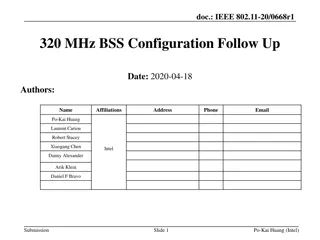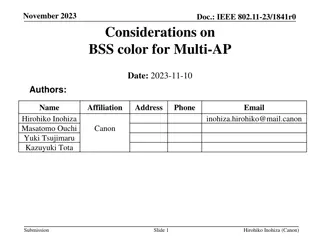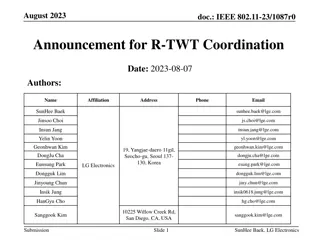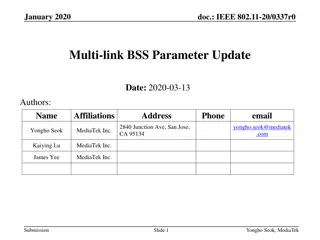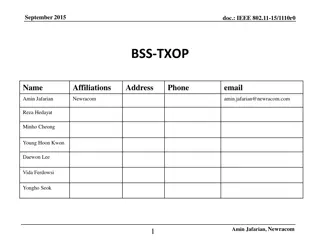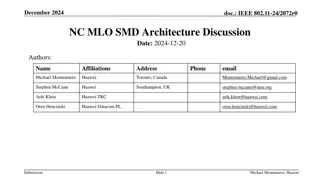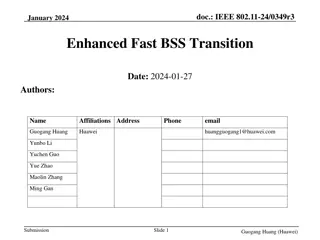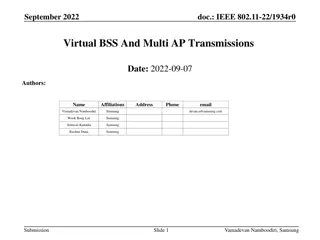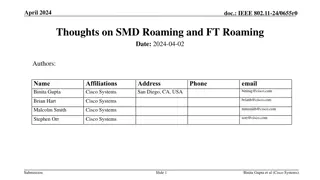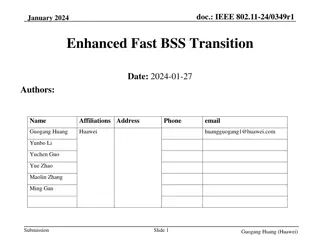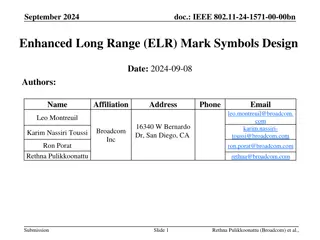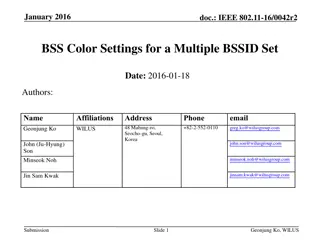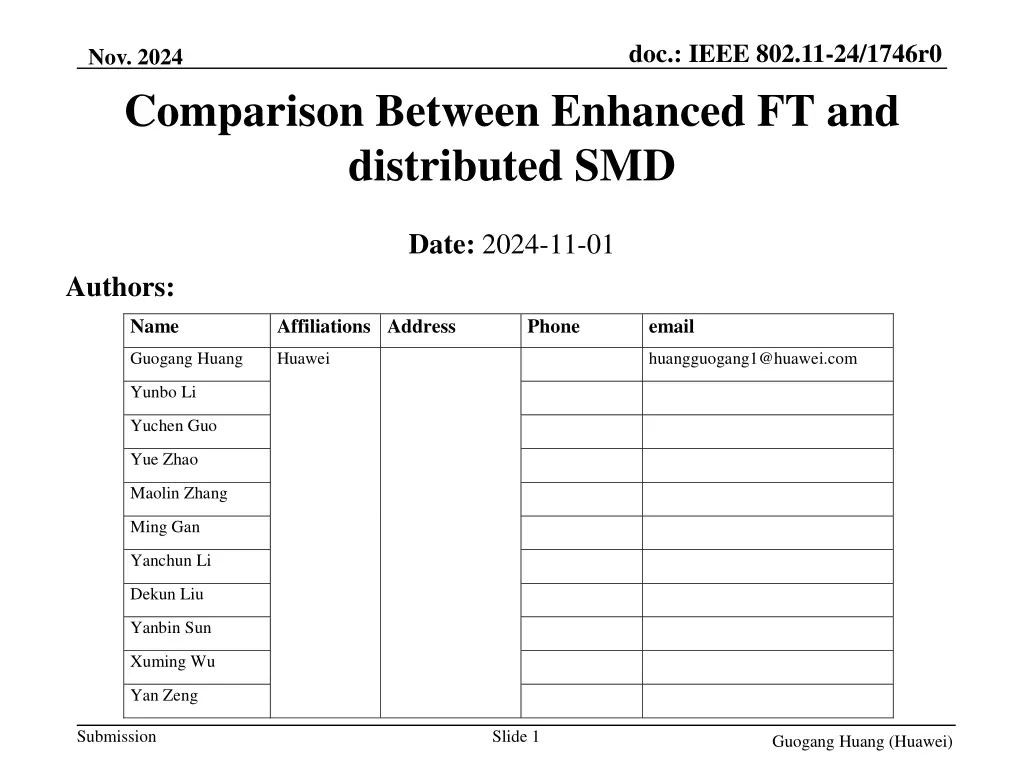
Comparison Between Enhanced FT and Distributed SMD
"Explore the differences between Enhanced Fast BSS Transition (FT) and Distributed Secure Mobility Domain (SMD) protocols in IEEE 802.11-24/1746r0. Delve into roaming architecture and security aspects for enhanced understanding." (255 characters)
Download Presentation

Please find below an Image/Link to download the presentation.
The content on the website is provided AS IS for your information and personal use only. It may not be sold, licensed, or shared on other websites without obtaining consent from the author. If you encounter any issues during the download, it is possible that the publisher has removed the file from their server.
You are allowed to download the files provided on this website for personal or commercial use, subject to the condition that they are used lawfully. All files are the property of their respective owners.
The content on the website is provided AS IS for your information and personal use only. It may not be sold, licensed, or shared on other websites without obtaining consent from the author.
E N D
Presentation Transcript
doc.: IEEE 802.11-24/1746r0 Nov. 2024 Comparison Between Enhanced FT and distributed SMD Date: 2024-11-01 Authors: Name Affiliations Address Phone email Guogang Huang Huawei huangguogang1@huawei.com Yunbo Li Yuchen Guo Yue Zhao Maolin Zhang Ming Gan Yanchun Li Dekun Liu Yanbin Sun Xuming Wu Yan Zeng Submission Slide 1 Guogang Huang (Huawei)
doc.: IEEE 802.11-24/1746r0 Nov. 2024 Introduction Roaming is one important MAC topic in 11bn. But now there is a fundamental divergence on the roaming architecture and security. Enhanced fast BSS transition (FT), in which different PTKSAs are used when roaming from the current AP MLD to target AP MLD. [1-3] Assuming both current AP MLD and target AP MLD belongs to the same mobility domain (MD) which is identified by a MD ID (2 octets). The PTKSA is bound with each AP MLD itself MAC address and non-AP MLD MAC address. Distributed SMD with PTK sharing, in which the same PTKSA is used and transferred when roaming from the current AP MLD to target AP MLD. [4-5] Assuming both current AP MLD and target AP MLD belongs to the same distributed SMD which is identified by a common MAC address. The PTKSA is bound with this common MAC address and non-AP MLD MAC address. In this contribution, we will provide some detailed comparisons between enhanced FT and distributed SMD with PTK sharing. Submission Slide 2 Guogang Huang (Huawei)
doc.: IEEE 802.11-24/1746r0 Nov. 2024 Enhanced FT In previous contributions [1-3], some candidate improvements are proposed to improve the performance of the current FT protocol, e.g. Improvement 1. Enable the context transfer and data forwarding to avoid the packet loss resulting from flushing the Tx/Rx buffer Reduce layer-2 packet loss Improvement 2. Enable the over-the-DS probing nearby APs which can avoid the transmission rate drop due to the off-channel scanning, especially for the EMLSR non-AP MLD. Simultaneously, define NDPR+NDPA+NDP to realize the RSSI measurement and time synchronization. [6] Improvement 3. Enable the over-the-DS reassociation without DS mapping change (e.g. defining FT Multi-link Setup Request/Response frame exchange) and use another Request/Response Request/Response) to trigger the DS mapping change and the context transfer. Multi-link setup PTK rederivation frame exchange (e.g. Roaming Submission Slide 3 Guogang Huang (Huawei)
doc.: IEEE 802.11-24/1746r0 Nov. 2024 Roaming Through Current AP MLD Distributed SMD MD Target AP MLD DS Current AP MLD Target AP MLD DS Current AP MLD Non-AP MLD Non-AP MLD 11kvr (Optional) 11kvr (Optional) Probe Request Probe Response FT Probe Request FT Probe Response Monitor RSSI with target AP MLD by using a short frame exchange NDPA/NDP) and select a propriate roaming point to change DS mapping and dynamic context transfer by sending Roaming Request. FT Multi-link Setup Request FT Multi-link Setup Response Link Reconfiguration Setup Request (e.g. Link Reconfiguration Setup Response ... ... Roaming Request Roaming Request Context Transfer Request Context Transfer Request DS-STA-NOTIFY .Request (MOVE) DS-STA-NOTIFY .Request (MOVE) Context Transfer Response Roaming Response Context Transfer Response Roaming Response Figure 1. Procedure of over-the-DS enhanced FT Figure 2. Roaming through current AP MLD under distributed SMD Submission Slide 4 Guogang Huang (Huawei)
doc.: IEEE 802.11-24/1746r0 Nov. 2024 Roaming Through Target AP MLD Note. Since the Link Reconfiguration Request is protected, the target AP MLD doesn t know which PTK shall be used to decrypt the received Link Reconfiguration Request frame. Hence, the non-AP MLD shall send an unprotected frame to inform the mapping relationship between TA and non-AP MLD MAC Address. MD A2 A3 Non-AP MLD Target AP MLD DS Current AP MLD Client A1 A4 A5 A6 Data A1-A6 are AP MLDs Authentication-Request Baseline RNR and BTM Query/Req/Resp Discovery phase: Client discovers and gathers basic information of neighboring AP MLDs following baseline procedures. APs do not commit resource ... Authentication-Response STA scans OTA (baseline) Baseline RNR and BTM Query/Req/Resp ... Reassociation Request BTM Query (A4, A5, A6) Roaming preparation phase: Candidate AP MLD set is formed here. Network commits resource Static context txfer Context Transfer Request Static context txfer BTM Request [(A4 [255], A5 [100], A6[0]), VI=T_hold] xx frame DS-STA-NOTIFY .Request (MOVE) Context Transfer Response Reassociation Response Link Reconfiguration Request (add A4) Roaming phase: Client transitions to the target AP MLD. Dynamic context txferred & data path switch Data Data Figure 3. Over-the-air enhanced FT protocol Figure 4. Roaming through target AP MLD under distributed SMD Submission Slide 5 Guogang Huang (Huawei)
doc.: IEEE 802.11-24/1746r0 Nov. 2024 Comparison on Retrieving Buffer Packets Simultaneously exchanging data with current AP MLD and target AP MLD The processing procedure is very similar to the one of DAPS (Dual Active Protocol Stack) handover defined in 5G cellular network. Figure 5. During roaming Figure 6. MAC Processing at non-AP MLD s side Submission Slide 6 Guogang Huang (Huawei)
doc.: IEEE 802.11-24/1746r0 Nov. 2024 Conclusions Compared with the enhanced FT, the distributed SMD with PTK sharing has no any benefit other than increasing the security risk. 11bn is expected to improve the Wi-Fi security, rather than regression in security. The distributed SMD with PTK sharing significantly conflicts with the goal of 11bn, i.e. ultra high reliability (UHR). Submission Slide 7 Guogang Huang (Huawei)
doc.: IEEE 802.11-24/1746r0 Nov. 2024 References [1] 11-23-1897-00-00bn-thoughts-on-improving-roaming-under-existing-architecture [2] 11-24-0349-03-00bn-enhanced-fast-bss-transition [3] 11-24-0679-04-00bn-thoughts-on-functionality-and-security-architecture-for-uhr- seamless-roaming [4] 11-24-0052-00-00bn-seamless-roaming-details [5] 11-23-2157-02-00bn-seamless-roaming-within-a-mobility-domain [6] 11-24-1414-02-00bn-channel-measurement-based-on-control-frame-exchange Submission Slide 8 Guogang Huang (Huawei)
doc.: IEEE 802.11-24/1746r0 Nov. 2024 SP Do you support in 11bn to improve the existing FT protocol? Note. According to the existing FT protocol, the FTO remains in state 4 during and after roaming to the other AP MLD. Submission Slide 9 Guogang Huang (Huawei)


